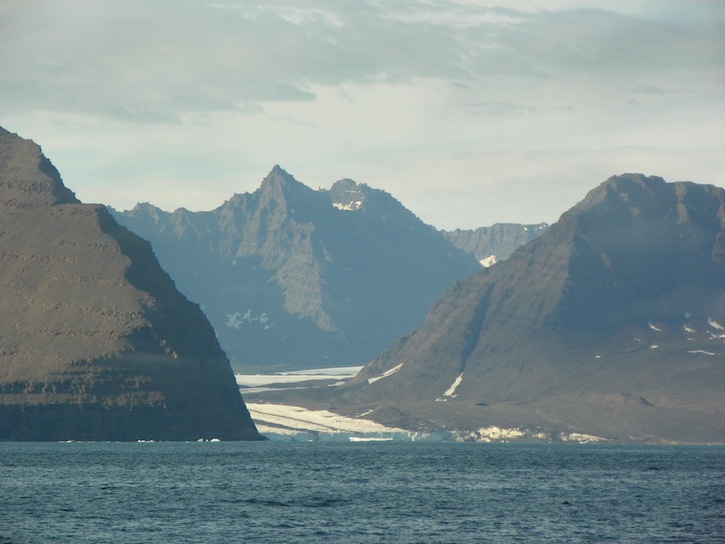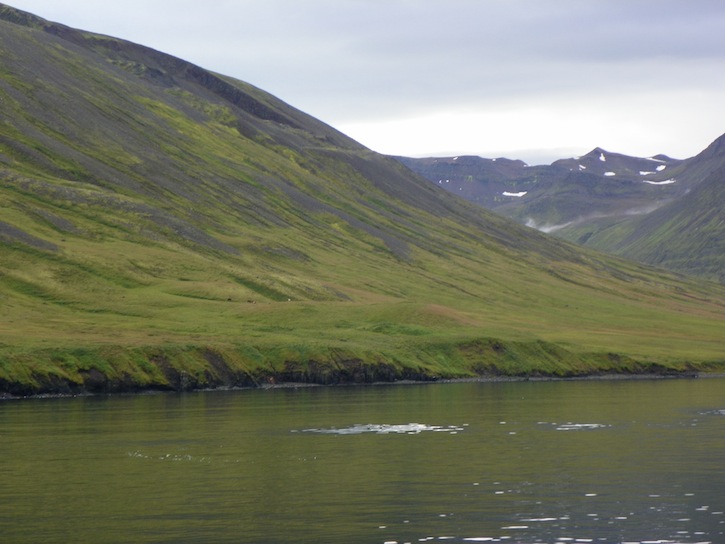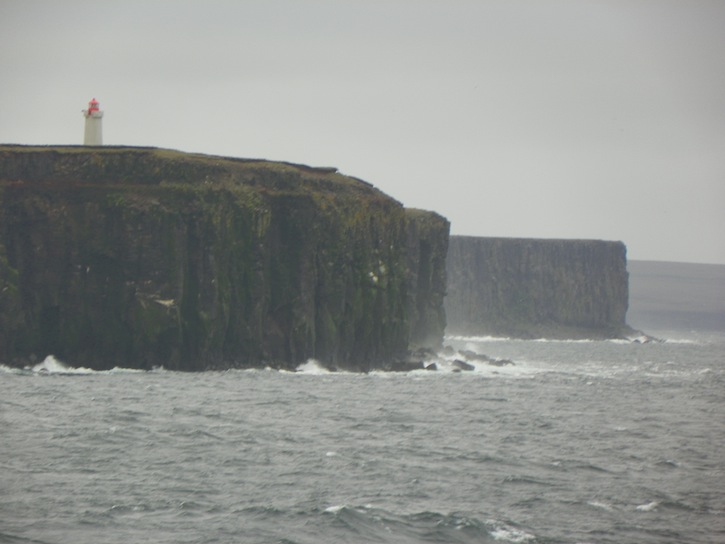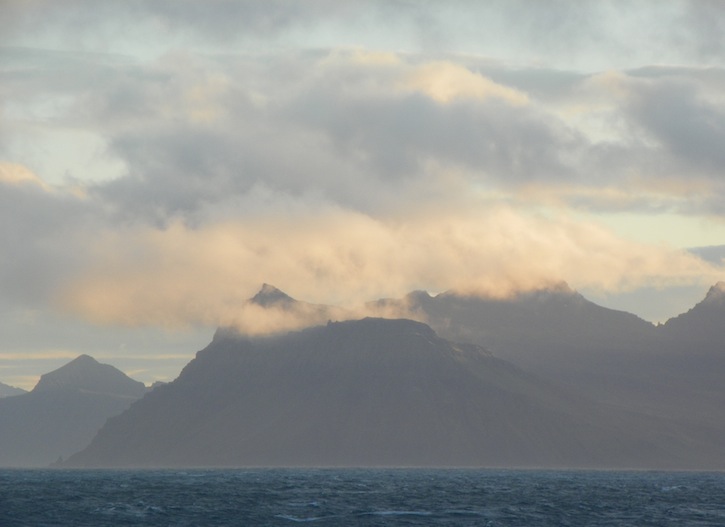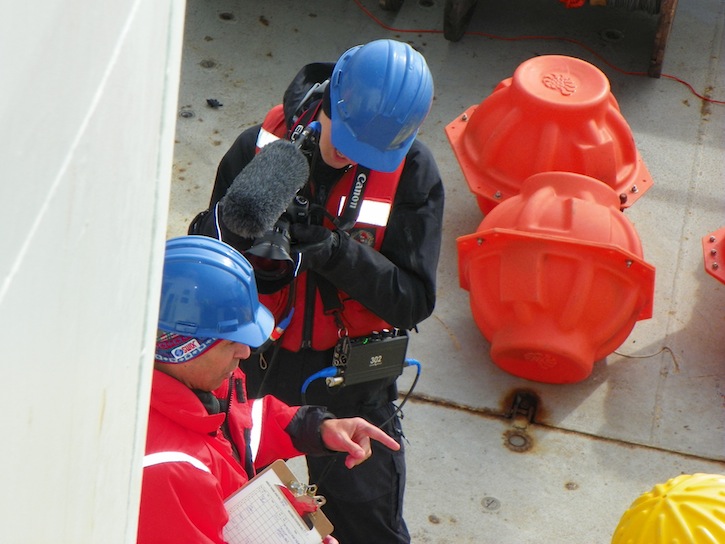Kari Lise Ellingsen and her students at Olsvikasen High School in Norway have obviously been keeping up with the science aboard the Knorr, especially with Sindre’s Norwegian blog. Thank you for these questions.
Question 1: If the melting of the Greenland icecap increases and all the freshwater runs into the ocean, will it matter for Norway and the Gulf Stream? And what about the DSOW? Answer: This is an important question. An enhanced outflow of freshwater from Greenland, due to increased rates of melting, could have an influence on the Atlantic meridional overturning circulation of which the Denmark Strait Overflow Water (DSOW) and the Gulf Stream's extension into the Nordic seas are central components. In particular, the surface layer of the area covered by the freshwater would be very light. As you may know, the density of water is determined by temperature and salinity (cold and salty waters are dense, warm and fresh waters are light), and the ocean is always layered such that lighter waters float on top of denser waters. During winter, when this surface layer is exposed to cold air, it would tend to freeze rather than become sufficiently dense to sink. As a result, there would be less production of dense water. If the region in question was an area that normally produced overflow waters, there could over some time be less overflow water available and perhaps a reduction in the transport of DSOW. Some modeling studies suggest that this could impact the inflow of warm Gulf Stream-origin waters and lead to a change in climate for northern Europe. Answered bt Kjetil Vage, Physical Oceanographer
An important source of freshwater entering the East Greenland Current from Greenland is glaciers and the icebergs that calve off of them. This is the glacier we saw on Cape Tupinier during our close encounter with the coast. © Pat Keoughan Question 2: How is the climate on Iceland influenced by the surrounding ocean currents? Answer: In short, the climate of Iceland is very much influenced by the ocean currents. The temperature of the sea around Iceland is much warmer than at similar latitudes elsewhere on the globe. So the warm North Atlantic Current that is the extension of the Gulf Stream is a kind of lifeline for Icelanders. It last happened during the years 1965 to 1971 that the cold surface water coming south along the East Greenland coast had been pressed further east and south closer to the shore of Iceland. This lead to increase in the amount of sea-ice north of Iceland and the frequent appearance of cold waters in the north and east. Not only did this effect the air temperature, but also the amount of plankton fell and the herring disappeared from these waters. This coincided with overfishing of the stock at the time. So the little inflow of warmer water that flows into the area north of Iceland, the North Icelandic Irminger Current has everything to do with the climate. Answered by Hedinn Valdimarsson, Physical Scientist
One of the Icelandic environments we visited on the Knorr was Suglufjordur on the north coast. With snow still on some of the mountains, there was evidence of glaciers moving through in the distant past. © Pat Keoughan
Langanes Peninsula sits on the north east point of Iceland topped by Langanes lighthouse. I had never seen such uniformly flat cliffs before. © Pat Keoughan
Higher and rockier than the mountains of Siglufjordur, not at all flat like Langanes, the east coast of Iceland is wild, though we did see snow high up on the mountains. © Pat Keoughan Question 3: Is the NIJ of any importance to the marine ecosystem in Iceland? Answer: It is just recently known how the North Icelandic Jet (NIJ) is lying outside the shelf and along the continental slope of Iceland. It flows deep and the role it has to play in the ecosystem is not known. I assume when people begin to think about this current when studying marine biology it probably will turn out that the NIJ has some effect. Unfinished scientific work did show a certain relation to distribution or type of bottom living creatures in the area northeast of the Denmark Strait. Answered by Hedinn Valdimarsson
Question 4: How is it possible to distinguish water masses by the use of isotopes? (We read in Sindre’s Norwegian blog that freshwater from the Greenland icecap is distinguished from distant saltier water by the use of isotopes.) Yes, we can determine the amount of freshwater mixed in with the saline (salty) sea water. But the freshwater I was talking about does not (necessarily) come from Greenland! It comes from different sources: precipitation (rain and snow), melting of sea ice in the Arctic, and some of it from melt and run off from the ice sheet on Greenland. But with the isotopes we can only determine whether the freshwater comes from precipitation (we call that meteoric) or from melting ice. In our calculations using the isotope data we do not differentiate between freshwater from melting sea ice or glacial melt.
Sindre Skrede interviews Chief Scientist Bob Pickart on the fantail during one of the mooring deployments in the Denmark Strait. © Pat Keoughan Question 5: What does it mean that your new results on the North Icelandic Jet may cause a paradigm shift? Answer: We are studying the origin of the cold, dense water that flows southward through the Denmark Strait. This topic has been studied extensively through the years and the oceanographic community eventually converged on the idea that the water enters the strait from the East Greenland Current (i.e. adjacent to Greenland). This represented a paradigm for the conversion of warm water into cold water in the Nordic Seas, and how the cold water subsequently flows equatorward. Our hypothesis suggests that there is more to the story. We argue that a significant part of the warm-to-cold conversion happens in the waters north of Iceland, and that the cold water then flows southward along the Iceland continental slope (not Greenland). This happens by a different process than the present explanation, and so it represents a new paradigm. If our hypothesis is correct (and it looks as if it is) then there are some important ramifications that need to be investigated. In other words, we have a lot more work to do! Answered by Bob Pickart, Chief Scientist Question 6: Have any of your hypothesis turned out to be totally wrong? Answer: There are many times when my ideas turn out to be wrong in some aspects. One of the exciting things about oceanography (and science in general) is that we are constantly surprised by the data we collect, which forces us to view things in a different light. Even on this cruise we've identified some puzzles that need explaining. While formulating a hypothesis is crucial for designing an experiment, in the end it is most important to obtain a more thorough understanding of the topic and using this knowledge to pursue further exciting problems. Answered by Bob Pickart Last updated: December 27, 2011 | |||||||||||
Copyright ©2007 Woods Hole Oceanographic Institution, All Rights Reserved, Privacy Policy. | |||||||||||


